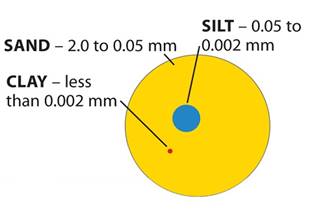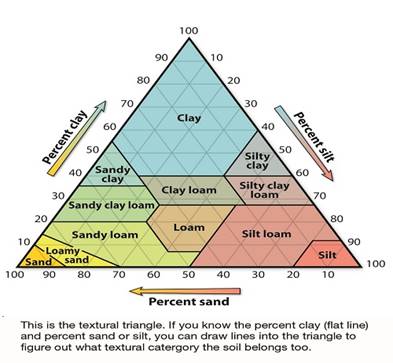
The particles that make up soil are categorized into three groups by size – sand, silt, and clay. Sand particles are the largest and clay particles the smallest. Most soils are a combination of the three. The relative percentages of sand, silt, and clay are what give soil its texture. A clay loam texture soil, for example, has nearly equal parts of sand, slit, and clay. These textural separates result from the weathering process.

This is an image comparing the sizes of sand, silt, and clay together. Sand is
the largest. Clay is the smallest.
The three different particles combined together at different ratios into a triangle shape to create 12 different soil textures. This triangle is used so that terms like “clay” or “loam” always have the same meaning. Each texture corresponds to specific percentages of sand, silt, or clay. Knowing the texture helps us manage the soil.

1) Use these word-combinations in your own sentences:
1. sand particles
2. to manage the soil
3. to result from
2) Put in the missing words according to the text.
1. This triangle is used so that terms like … or …. always have the same meaning.
2. Knowing …. helps us manage …. .
3. These textural separates result from … .
3) Read the following text and give it the title.
Soil structure is the arrangement of soil particles into small clumps, called peds or aggregates. Soil particles (sand, silt, clay and even organic matter) bind together to form peds. Depending on the composition and on the conditions in which the peds formed (getting wet and drying out, or freezing and thawing, foot traffic, farming, etc.), the ped has a specific shape. They could be granular (like gardening soil), blocky, columnar, platy, massive (like modeling clay) or single-grained (like beach sand). Structure correlates to the pore space in the soil which influences root growth and air and water movement.
Скачано с www.znanio.ru
Материалы на данной страницы взяты из открытых источников либо размещены пользователем в соответствии с договором-офертой сайта. Вы можете сообщить о нарушении.